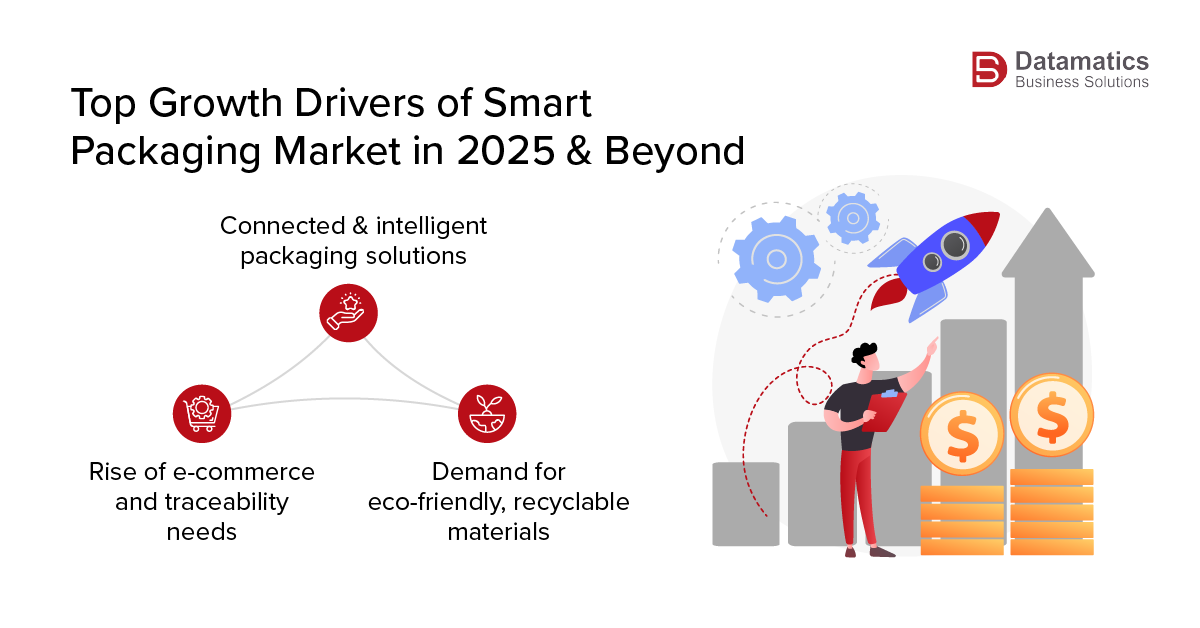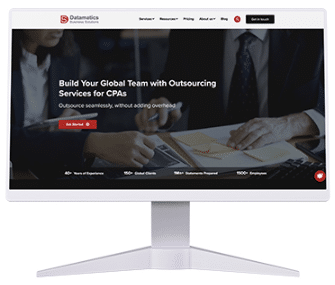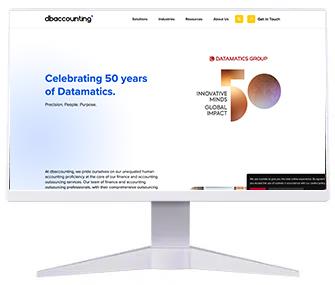What Is Driving the Surge in the Smart Packaging Market?
Several intersecting forces are driving the global smart packaging market. In this blog, we will take a closer look at the key drivers, the push for sustainability through eco-friendly materials and recyclability, technological advancements in the smart packaging industry, such as AI, automation, and 3D printing, and personalization supported by statistics and insights, with attention to how different industries are affected.
If you own a business in this space or plan to build one, here is everything you need to know.
 Select an element to maximize. Press ESC to cancel.
Select an element to maximize. Press ESC to cancel.Why Product Safety, Traceability, and Regulatory Compliance are Powerful Levers?
The concerns around safety, traceability, and regulatory compliance do not come only from consumers; they are now enforced by law and by brand risk management:
- Food & Beverage Industry: Considering that many modern smart packaging technologies, such as active packaging and intelligent labels, are used to monitor freshness, temperature, and spoilage, they offer ways to minimize waste and avoid any safety risks involved. A good example of it can be seen in the increasing use of active packaging in meat, dairy, and fresh produce sectors for controlling oxygen, moisture, and microbial activity.
- Pharmaceuticals/Healthcare: Tamper-evident packaging, serialization, and temperature-sensitive monitoring (cold chain) are crucial. The pharmaceutical and healthcare industries are among the most heavily regulated, with failure (e.g., spoilage or counterfeit) carrying a high risk. Pharma is one of the leading growth drivers in the RFID-integrated smart packaging subset.
- Governments across Europe, North America, and in several parts of Asia are introducing strict rules for traceability, labelling, safety, and anti-counterfeiting. The increasing regulatory requirements in the industry are making smart packaging essential.
 Select an element to maximize. Press ESC to cancel.
Select an element to maximize. Press ESC to cancel. Select an element to maximize. Press ESC to cancel.
Select an element to maximize. Press ESC to cancel.How are sustainability and waste reduction key levers?
The growing emphasis on eco-concerns can be directly linked to the significant growth in the smart packaging sector, especially where packaging can help reduce waste, improve recyclability, lower a carbon footprint, or enable material innovation.
- In the food and beverage industry, smart packaging, such as temperature or freshness indicators and moisture/oxygen control, plays a significant role in reducing spoilage and consequently waste. According to industry reports, the use of extra packaging can help extend shelf life by as much as 30–50% in certain categories.
- The increasing number of sustainability initiatives is also cited as the top motivator for connected packaging adoption: e.g., in the 2025 connected packaging survey, ~51.9% cited sustainability & recycling as a driver.
- Biodegradable smart materials and “active + intelligent” packaging segments, which bring together sensor and material innovations, are growing.
 Select an element to maximize. Press ESC to cancel.
Select an element to maximize. Press ESC to cancel. Select an element to maximize. Press ESC to cancel.
Select an element to maximize. Press ESC to cancel.What Technological Progress and Cost Factors are Enabling Broader Adoption?
The broader adoption of smart packaging is driven not only by increased demand but also significantly by supply-side innovations. All these factors are making smart packaging more feasible and cost-effective:
- The cost of NFC chips, RFID tags, sensors, and IoT components is constantly decreasing, making scalability, integration with automated manufacturing & supply chain systems, and deployment more viable.
- The significant improvement in 3D printing and growing use of automation in packaging lines, along with advanced sensor embedding and material engineering, is enabling complex smart packaging e.g., multi-layer films with active agents, moisture/oxygen control, freshness or spoilage indicators to be manufactured at scale.
- The RFID-integrated smart packaging segment is expected to grow at a steady pace, primarily driven by the technological advancements in the sector.
Regional Variation: Where Growth is Strongest and Why?
- The Asia-Pacific region is fast becoming the growth engine for the smart manufacturing industry. India’s CAGR is expected to be around 6.1%, while China is showing strong signs with a growth rate of ~5.8%, driven by increasing incomes, regulatory pressure, the expansion of the food & pharma sectors, and consumer demands for safety & traceability.
- North America is growing comparatively at a slower pace than Asia; however, it is showing promising signs due to increased regulatory requirements, investment in technology, rising consumer expectations, e-commerce growth, and healthcare demand. There have also been significant advancements in the adoption of IoT/RFID/intelligent packaging.
- The European region is also driven by regulations, including food safety, bans on single-use plastics, anti-counterfeiting laws, and sustainability mandates. This enforcement is driving growth in the smart packaging sector, making it competitive and compliant.
Certainly! Let’s delve deeper into how sustainability and eco-friendly materials are transforming packaging, with a focus on key players, their offerings, and insights that can make this segment more engaging for the reader.
 Select an element to maximize. Press ESC to cancel.
Select an element to maximize. Press ESC to cancel.
How Are Sustainability and Eco-Friendly Materials Transforming Packaging?
In the current market, sustainability is no longer a passing fad; it’s the fundamental shift in how businesses approach packaging. Businesses worldwide are proactively adopting biodegradable materials and minimizing the use of plastic to meet the global environmental standards and consumer demands. Once significant example of it is Xampla, a UK-based green tech firm, which is pioneering biodegradable alternatives made from plant proteins to replace single-use plastics.
With its range of innovative materials under its brand Morro™, Xampla intend to eradicate the most polluting plastics. These materials have been created using natural plant based proteins such as peas, rapeseed, and sunflower, and are fully biodegradable. All their materials are home compostable, and compatible with international standard recycling processes. Xampla uses the natural ability of proteins to be structured into high-performance materials without introducing any chemical modification.
Other Industry Leaders in Sustainable Packaging
While Xampla is one of the industry leader, there are several other noteworthy players making significant strides in sustainable packaging:
- Notpla: Specializing in seaweed-based packaging solutions, Notpla offers alternatives to plastic bottles and sachets. All their products are edible, biodegradable and innovative solutions to reduce plastic waste.
- Sulapac: A Finnish company, Sulapac produces biodegradable and microplastic-free materials from wood and natural binders. Their products are developed to replace the use of plastic in cosmetics and food packaging.
- Loliware: Made from seaweed, Loliware produces edible and biodegradable cups and straws. They focus primarily on the foodservice industry and have a singular goal to eradicate plastic waste.
 Select an element to maximize. Press ESC to cancel.
Select an element to maximize. Press ESC to cancel.The Impact on Consumer Behavior and Industry Standards
The move towards sustainable packaging is not only about minimizing the environmental impact of single use plastic, it is also to influence consumer behavior and industry standards. Modern consumers are more aware of the impact of plastic on environment and prefer to purchase products that have the lowest environmental footprint of the products, leading to increased demand for eco-friendly packaging solutions.
Moreover, the global regulatory requirements are also fuelling this transformation. For instance, the European Union’s Single-Use Plastics Directive and the UK’s extended producer responsibility laws are pushing companies to adopt sustainable packaging practices to comply with environmental regulations.
 Select an element to maximize. Press ESC to cancel.
Select an element to maximize. Press ESC to cancel.How Are Technological Advancements Shaping Packaging Innovations?
The tremendous advancements in Artificial Intelligence (AI), the Internet of Things (IoT), and 3D printing are revolutionizing the smart packaging industry. These technologies are helping businesses transform their product development processes by providing them with data-backed insights and real-time information
AI: Enhancing Design and Efficiency
The tremendous growth in the AI world is driving packaging innovation, helping brands optimize designs, streamline production, and enhance customer engagement.
- Design Optimization: With advanced AI algorithms, brands can now analyze consumer preferences and market trends in-depth to create packaging designs that resonate with their target audiences. It helps them create more personalized and appealing packaging solutions.
- Predictive Analytics: AI-driven predictive analytics enables brands to predict consumer behaviour, enabling them to adjust packaging strategies proactively.
- Automation: AI facilitates automation in packaging lines, reducing human error and increasing efficiency.
 Select an element to maximize. Press ESC to cancel.
Select an element to maximize. Press ESC to cancel.Key Players:
Materialise: Offers AI-driven packaging design automation tools, enabling brands to develop prototypes more quickly and offer enhanced customization.
HP Inc.: Leading player in multi-jet fusion 3D printing for scalable packaging, integrating AI to optimize design and production processes.
Stratasys: Offers multi-material 3D printing for packaging durability, significantly improving the aesthetics and functionality of packaging solutions.
 Select an element to maximize. Press ESC to cancel.
Select an element to maximize. Press ESC to cancel. Select an element to maximize. Press ESC to cancel.
Select an element to maximize. Press ESC to cancel.IoT: Real-Time Monitoring and Consumer Interaction
IoT integration using sensors enables brands to gain real-time monitoring of their production lines and enhance consumer engagement.
- Real-Time Monitoring: With IoT-enabled packaging, companies can seamlessly track product conditions, such as humidity and temperature, ensuring safe and quality production lines.
- Consumer Engagement: Smart packaging with IoT capabilities enables customers to interact with products using their smartphones, curate personalized experiences, and access information more quickly.
 Select an element to maximize. Press ESC to cancel.
Select an element to maximize. Press ESC to cancel.Key Players:
- Avery Dennison: Offers IoT-enabled RFID tags, helping brands manage their inventory in real-time and boost consumer engagement.
- Smarter Packaging Solutions: Develops smart packaging solutions that integrate IoT technology for monitoring product conditions and enhancing consumer interaction.
3D Printing: Customization and Sustainability
3D printing gives brands unprecedented opportunities for customization and sustainability in packaging.
- Customization: Using 3D printing, brands gain the ability to create unique and personalized packaging designs that can be further tailored to meet specific product or branding requirements.
- Sustainability: 3D printing helps minimize waste and energy consumption, which in turn contributes to the development of more sustainable packaging solutions.
 Select an element to maximize. Press ESC to cancel.
Select an element to maximize. Press ESC to cancel.Key Players:
- 3D Systems: A leader in developing bio-based, food-safe 3D-printed packaging materials, which promotes sustainability in packaging.
- EOS GmbH: Strengthens recyclable polymer printing solutions, advancing eco-friendly packaging options.
- Markforged: Releases metal-infused, high-durability 3D-printed packaging structures, enhancing the strength and functionality of packaging materials.
For every business seeking to adopt sustainability and remain competitive in the smart packaging industry, harnessing the power of advanced AI, IoT, and 3D printing is crucial. It will not only help them increase their efficiency but also unlock several opportunities for innovation and differentiation.
By partnering with industry leaders in these technologies, businesses can gain the ability to develop packaging solutions that meet consumer expectations and regulatory standards, driving growth and brand loyalty.
| Industry | Factors Driving Smart Packaging Adoption | Key Stats / Examples |
|---|---|---|
| Food & Beverage |
|
~30%. Food & Beverage accounts for ~45–50% share of smart packaging market by type/application in many reports. |
| Pharmaceuticals & Healthcare |
|
RFID-integrated smart packaging shows strong growth in pharmaceutical demand, with pharma & logistics as key growth verticals. |
| Personal Care & Cosmetics |
|
~35–40% rise in anti-counterfeit/NFC labels. |
| Logistics / Cold Chain / E-commerce |
|
Asia-Pacific shows rapid growth in connected cold-chain packaging; smart labels for real-time monitoring widely used in food and pharma logistics. |
Conclusion: Embracing the Future of Packaging
With technological advancements transforming every business around the world, the future of packaging will belong to the business that masterfully blends innovation with insight. By staying up-to-date with market trends, emerging materials, and technology adoption, businesses will have the ability to make proactive decisions. This is why partnering with a custom research and market intelligence firm can unlock actionable insights for you and help you identify the right materials, technology partners, and design strategies tailored to specific industries and geographies.
If you are ready to transform your packaging strategies, we have the insights and resources for you. Write to us at marketing@datamaticsbpm.com, and we will have our market research experts reach out to you with strategies tailored perfectly for your business requirements.
 Select an element to maximize. Press ESC to cancel.
Select an element to maximize. Press ESC to cancel.
Somnath Banerjee


